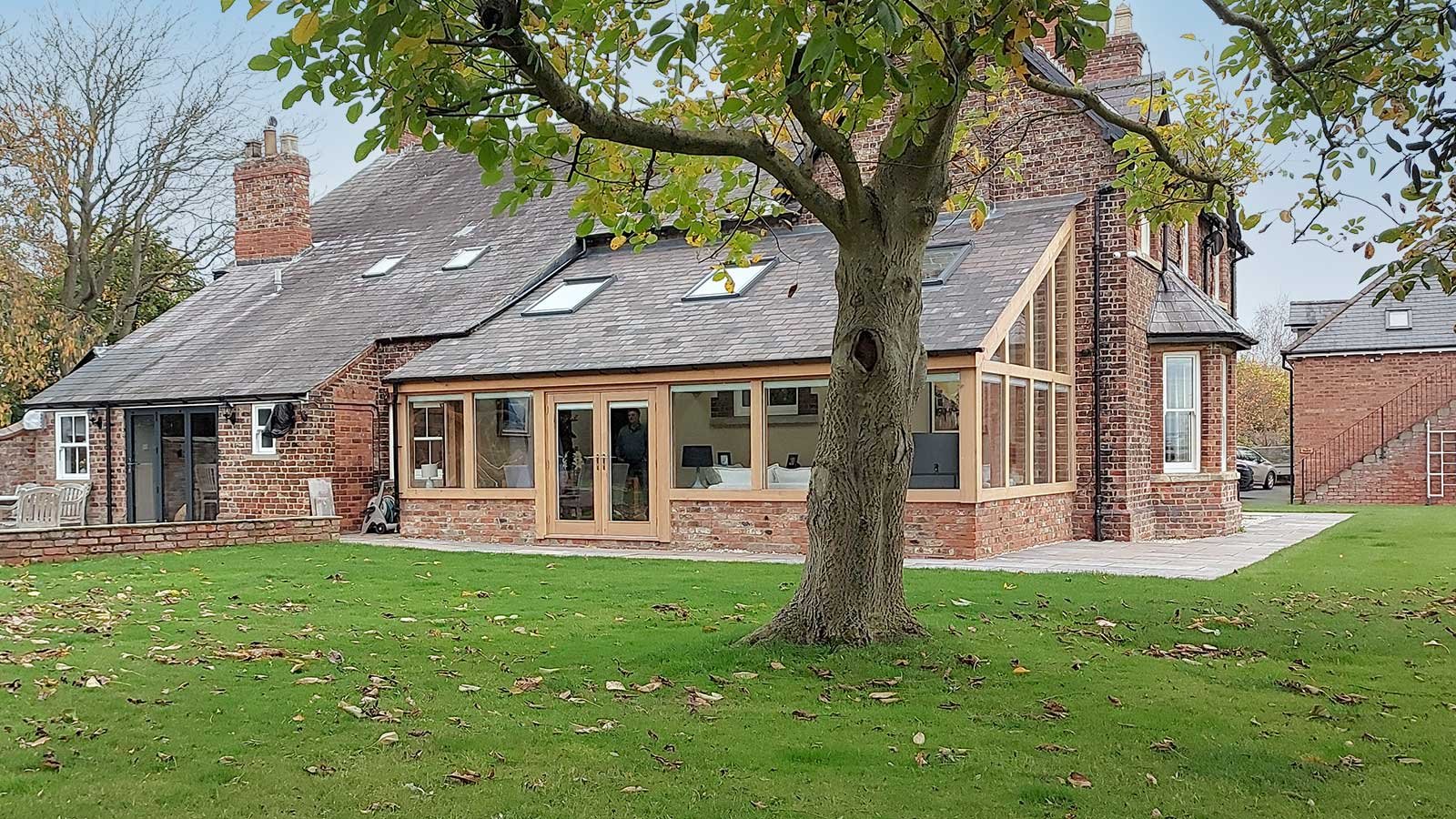
oakbydesign
01423 593 794


The newly built oak garden room has changed how the family of this beautiful Victorian home on the north of York use their home.
Dominic and his wife, Lucy, bought the house in 2015. The house had originally been in its own grounds and had been part of a farm. Over the years, the land to the front and side of the property was sold for housing and when the Sharkey's bought their home, the houses around were well established.
Not long after they had moved in, Dominic had a fabulous offer to move his family to America for 4 years with work. Not wanting to miss this once in a lifetime opportunity the family took off and rented their home out.
On returning, they decided to make a few changes.
The Problem:-
The back and side of the property have amazing views across the fields, yet none of the homes' rooms looked directly onto them. The main reception rooms looked onto the front garden, and beyond, to their neighbours properties.
An old, small conservatory stood at the back of the house (see photo in the lower section of a before photo) and they decided to replace this. Once they started looking online for ideas, the size of the replacement room grew!
Searching online, they came across Oak By Design and liked one of their Oak Garden Room projects in particular that was on their Case Study section of the website. They emailed them in October 2021 via their website, asking for more information and guidance.
Joanne contacted David and took details of their initial ideas.
As they didn't have a builder, Joanne recommended Jack Stout, a York based builder who has installed numerous oak buildings for our customers.
Dominic contacted him and Jack visited their home. After listening to their ideas and taking into account existing features of the home, he made suggestions.
Once a design was agreed, and measurements taken, and sent to Joanne, a ballpark quotation was provided. The quotation was accepted.
The timbers for the main external framework are 140mm x 140mm but internally, large mono trusses span the width of the 4.5m room. These 2 trusses are an integral part of the structure of the building, but they have also provided a great amount of Wow Factor to the room.
A structural engineer calculated the sizes required and these are beauties at 190mm high.
These had to be positioned above an upright timber on the main framework but also had to 'sit' within the house wall to support them.
There is an existing window in the room, which was originally on the external wall of the house before the new building was installed. This large, staircase window has become a feature of the room too.
The mono trusses had to avoid this, and also avoid being sited above the double oak French doors that lead out to the garden.
A final design was achieved, ensuring all the above points were ticked off.
Jack completed all the ground works, and when the framework for the new oak garden room and glazing was ready, installed the framework, trusses and purlins, and fit the roof.
The original external door from the house into the garden became the door into the new oak garden room from their hallway . Dominic and Lucy wanted to change the door to a glazed one, to let light into the main hallway of the home.
This was made, along with its own doorframe, and was supplied pre hung, and all ironmongery fit, for quicker installation by Jack. Jack created the curved effect above the opening.
Three Velux windows were fit within the sunrooms roof. These bring light into the oak garden room, and can also help ventilate the room.
The Sharkeys also installed 'Top Down, Bottom Up' blinds for the lower windows in the room. The room faces both South and West and so receives plenty of sunlight. These blinds can be positioned in just the areas where the sun is bright, or where privacy is required. The rest of the window can then be 'open'.
Speaking to the Sharkeys after they had decorated and furnished and 'moved in' they said:-
"The size of the room evolved over time to become the large garden room we now have. We wanted to use the space at the back of the house that has the privacy and the views.
"More importantly, we have created a room, which we tend to use when the children have gone to bed. We have the television in here, and large comfy sofa's. In fact furnishing the room was harder than we anticipated. The first sofa's we bought were too small when they arrived. The room needs large, bold furniture to suit the height and proportions of the room, but we have it just perfect now with the oversized chairs and sofas".
At 8.5metres x 4.5metres, this sitting/dining room has certainly created some Wow factor on the home.
Oak conservatories offer a myriad of benefits that make them a popular choice among homeowners seeking to enhance their living spaces. The timeless allure and natural beauty of oak, combined with its remarkable durability, create an atmosphere that is both inviting and refined.
One advantage of oak conservatories is their ability to seamlessly integrate with the surrounding environment. The use of this exquisite material allows for the creation of harmonious spaces that blend effortlessly into any landscape. The rich, warm tones and distinctive grain patterns evoke a sense of tranquility, making oak conservatories the perfect retreat for relaxation and contemplation.
In addition to their aesthetic appeal, oak conservatories are renowned for their longevity. Oak is known for its resilience and strength, ensuring that these structures will endure for generations to come. This inherent durability also reduces maintenance requirements, making oak conservatories a cost-effective investment in the long run.
Furthermore, oak conservatories provide excellent thermal insulation. The natural properties of oak allow it to retain heat during colder months while keeping the interior cool in summer. This energy efficiency not only creates a comfortable living environment but also helps reduce heating and cooling costs.
Lastly, oak conservatories have a timeless charm that adds significant value to any property. Their classic design transcends passing trends, ensuring enduring elegance throughout the years.
In conclusion, oak conservatories offer numerous advantages including seamless integration with the surroundings, exceptional durability, superior thermal insulation, and timeless charm. These features make them an ideal choice for homeowners seeking to create sophisticated and captivating living spaces that stand the test of time.
Green oak and air-dried oak are two distinct types of timber that differ in their characteristics. Understanding these differences is crucial for anyone involved in the construction or woodworking industry.
When comparing green oak to air-dried oak, one can draw an analogy with the concept of aging wine. Just as wine needs time to mature and develop its unique flavors, green oak requires a seasoning process to achieve optimal quality.
During the seasoning process, green oak gradually loses moisture content through natural drying methods. This reduction in moisture not only improves the stability of the wood but also prevents excessive movement and shrinkage over time. It is comparable to how aging wine develops complexity while maintaining stability.
On the other hand, air-dried oak undergoes a different drying method. Once cut into sizeable timber pieces, it is left outside to dry naturally over an extended period. The exposure to open air allows for gradual moisture loss through evaporation, resulting in lower moisture content compared to green oak.
The metaphorical comparison between green oak and aging wine helps illustrate how both processes require patience and time for desirable outcomes. Just as aged wine showcases its refined qualities after years of maturing, air-dried oak represents a stable and reliable material due to its prolonged seasoning period.
In summary, understanding the distinction between green oak and air-dried oak is essential when choosing timber for construction purposes. Whether opting for freshly felled or naturally dried wood, each has its advantages based on specific project requirements and desired characteristics.
Double glazing, also known as a double glazed unit (DGU), is a widely used element in building construction due to its numerous benefits. This article aims to discuss the advantages of double glazing within the context of thermal insulation.
The primary advantage of incorporating double glazing into building design lies in its ability to provide effective thermal insulation. By utilising two sheets of glass separated by a spacer bar, an air gap is created within the DGU, which can be filled with an insulating gas. This configuration acts as a thermal barrier, preventing heat from escaping and cold air from infiltrating a room.
To illustrate this phenomenon, we can imagine the DGU functioning like a sandwich. The sheets of glass serve as the bread slices while the air gap represents the filling. Just as a sandwich preserves warmth and prevents external elements from permeating it, double glazing similarly retains heat within enclosed spaces while impeding cold drafts from entering.
This enhanced insulation results in improved energy efficiency for buildings that incorporate double glazed windows. By reducing heat loss during colder months and minimising heat gain during warmer months, these windows contribute to maintaining comfortable indoor temperatures without excessive reliance on heating or cooling systems.
In conclusion, through its thermal insulation properties, double glazing plays a crucial role in enhancing the energy efficiency of buildings. By utilising this technology, builders can create more sustainable structures that optimise comfort while reducing energy consumption and associated costs over time.
Telephone: 01423 593 794
Locksley Park
Blind Lane
Tockwith
YORK YO26 7QJ
Opening Times:
Mon to Fri - 9.00am to 5.00pm
Bank Holidays - Closed
Christmas 2025- TBC
Oak By Design is the trading name of:
Oak By Design Ltd.
Reg Number: 04384416
VAT Number: 664 8012 33